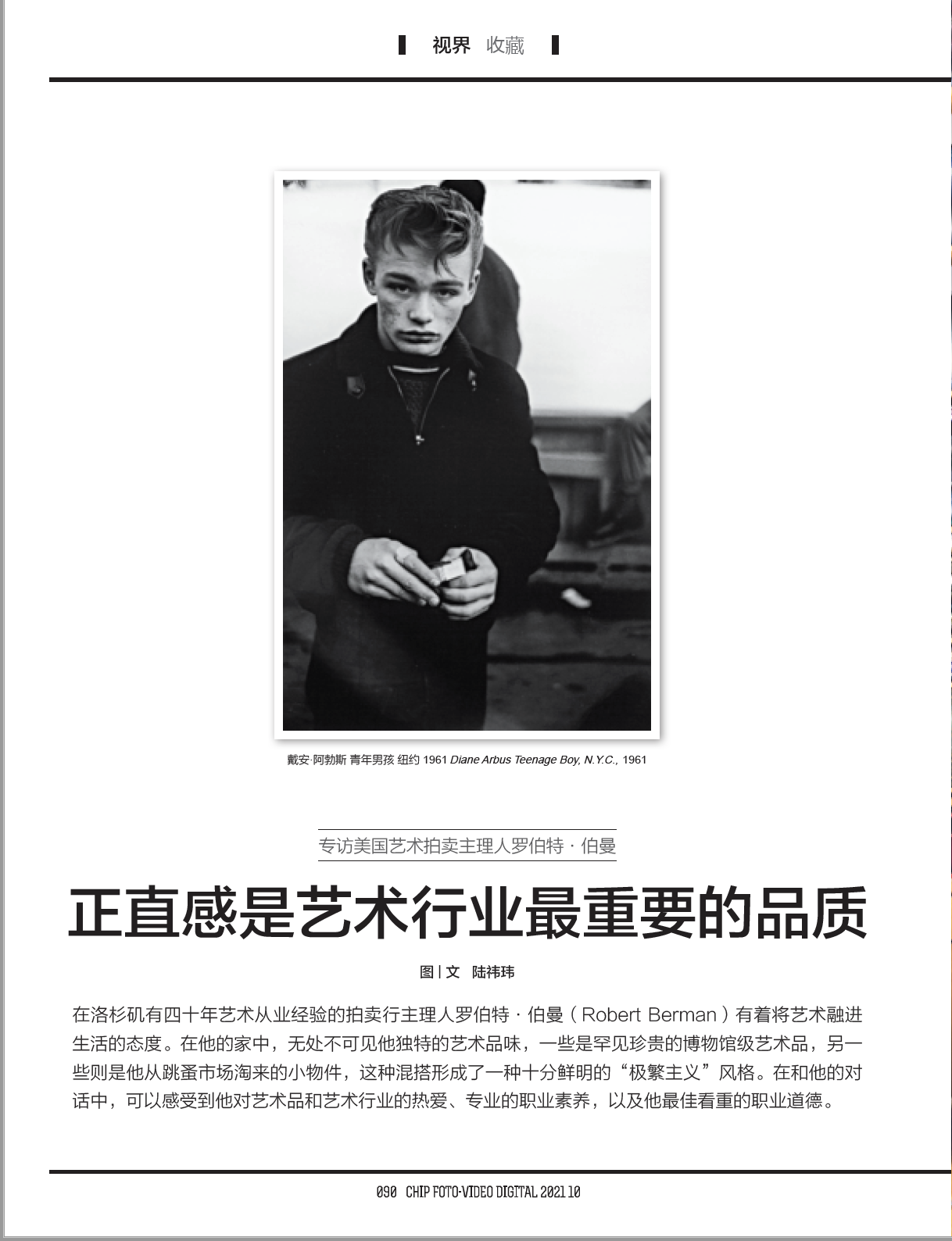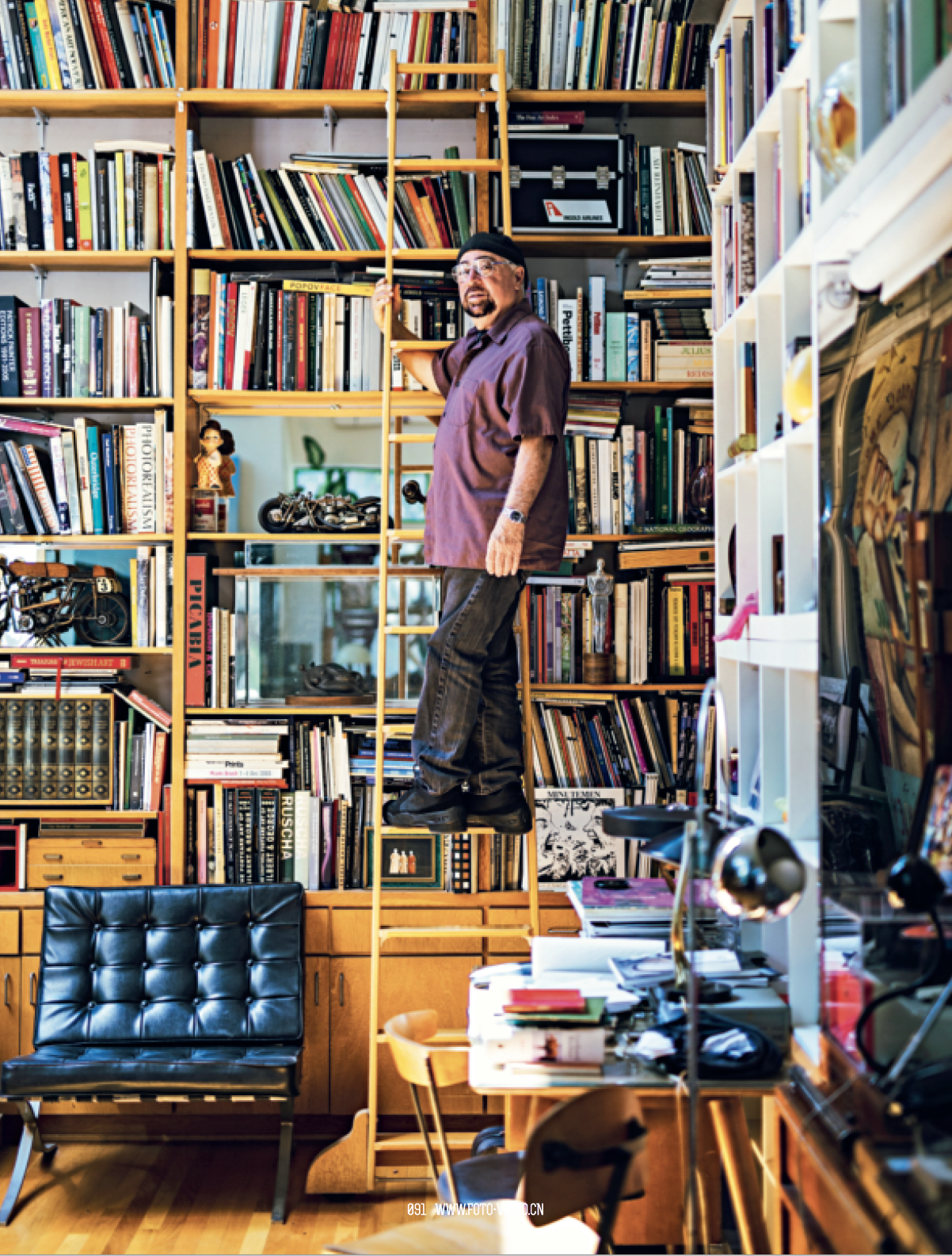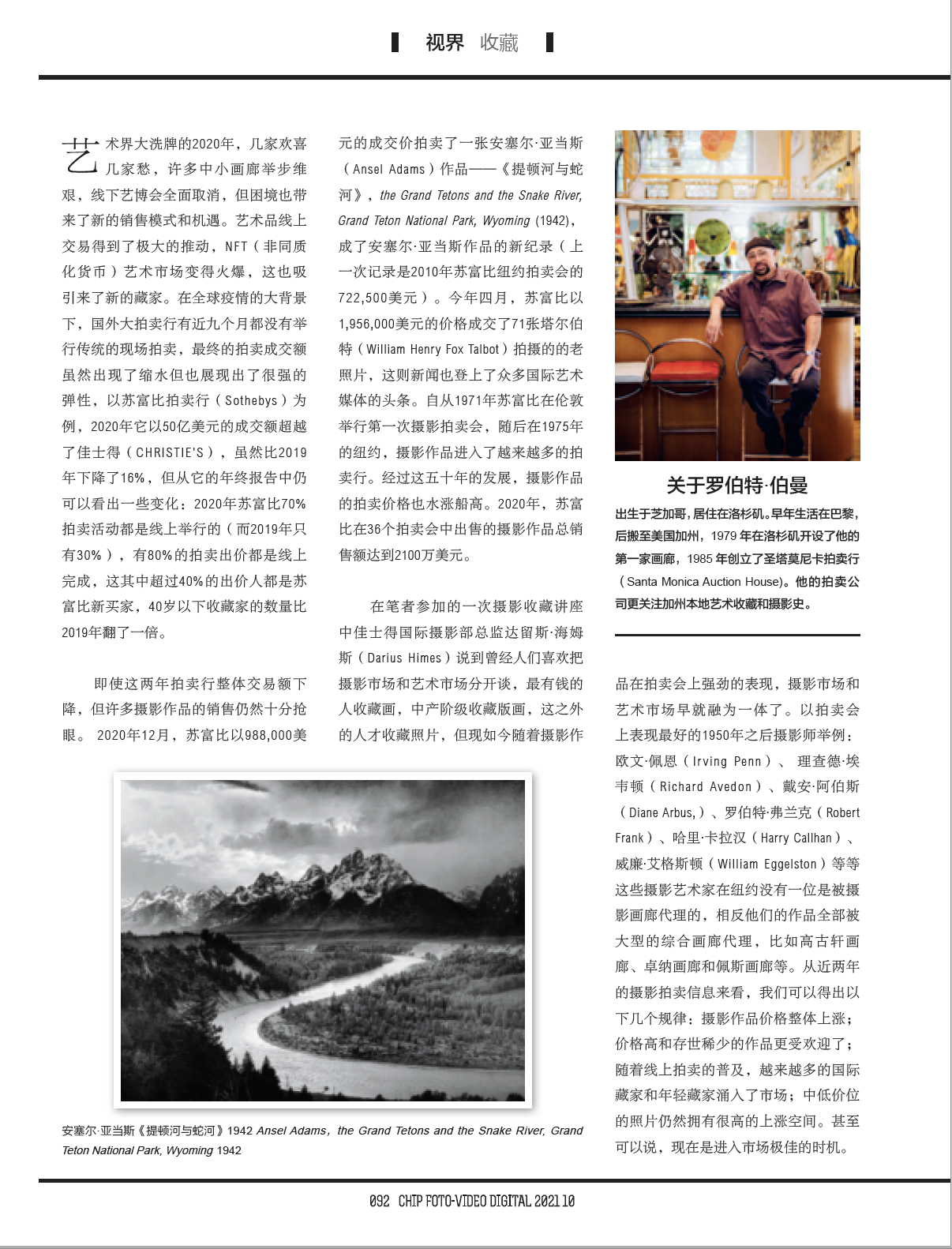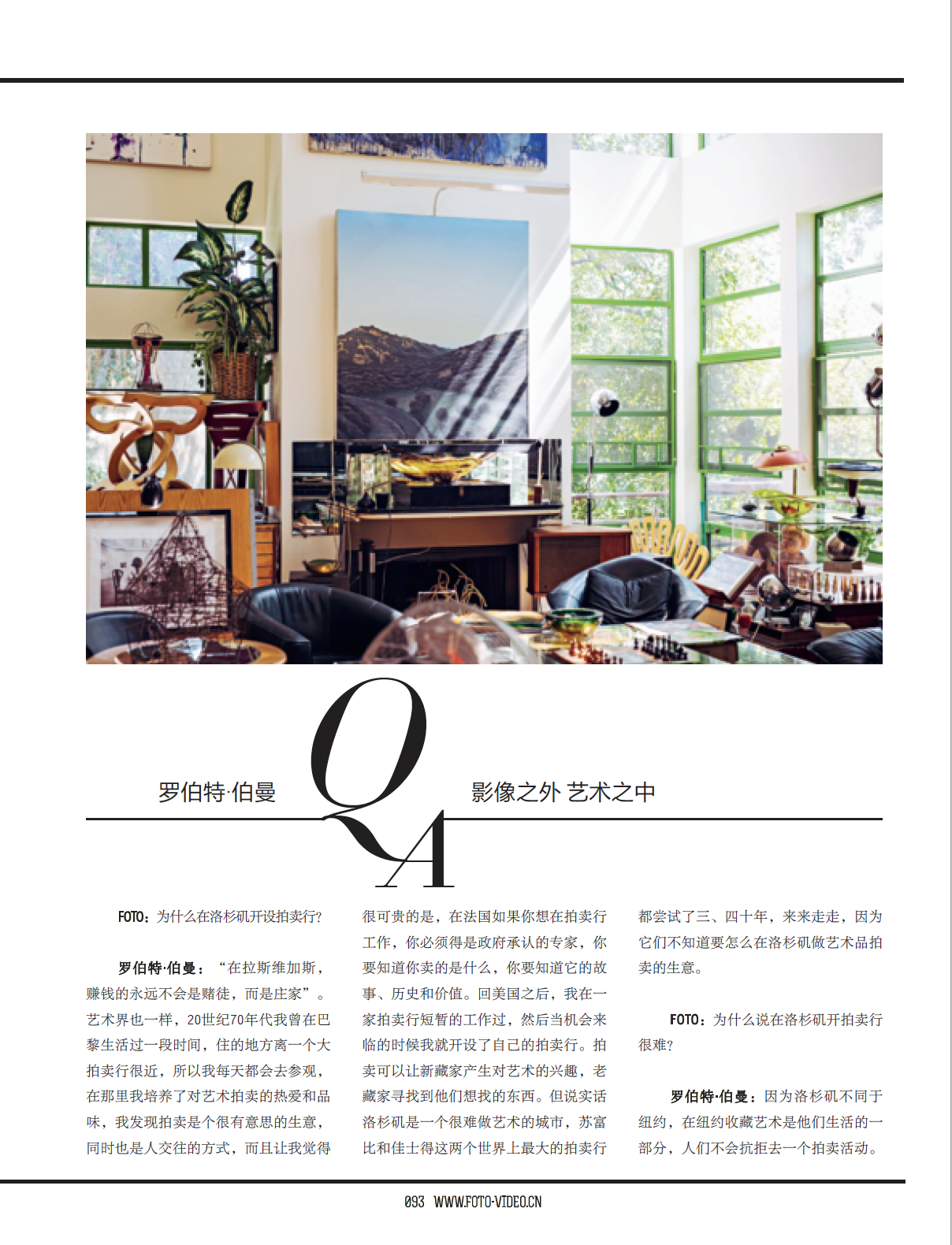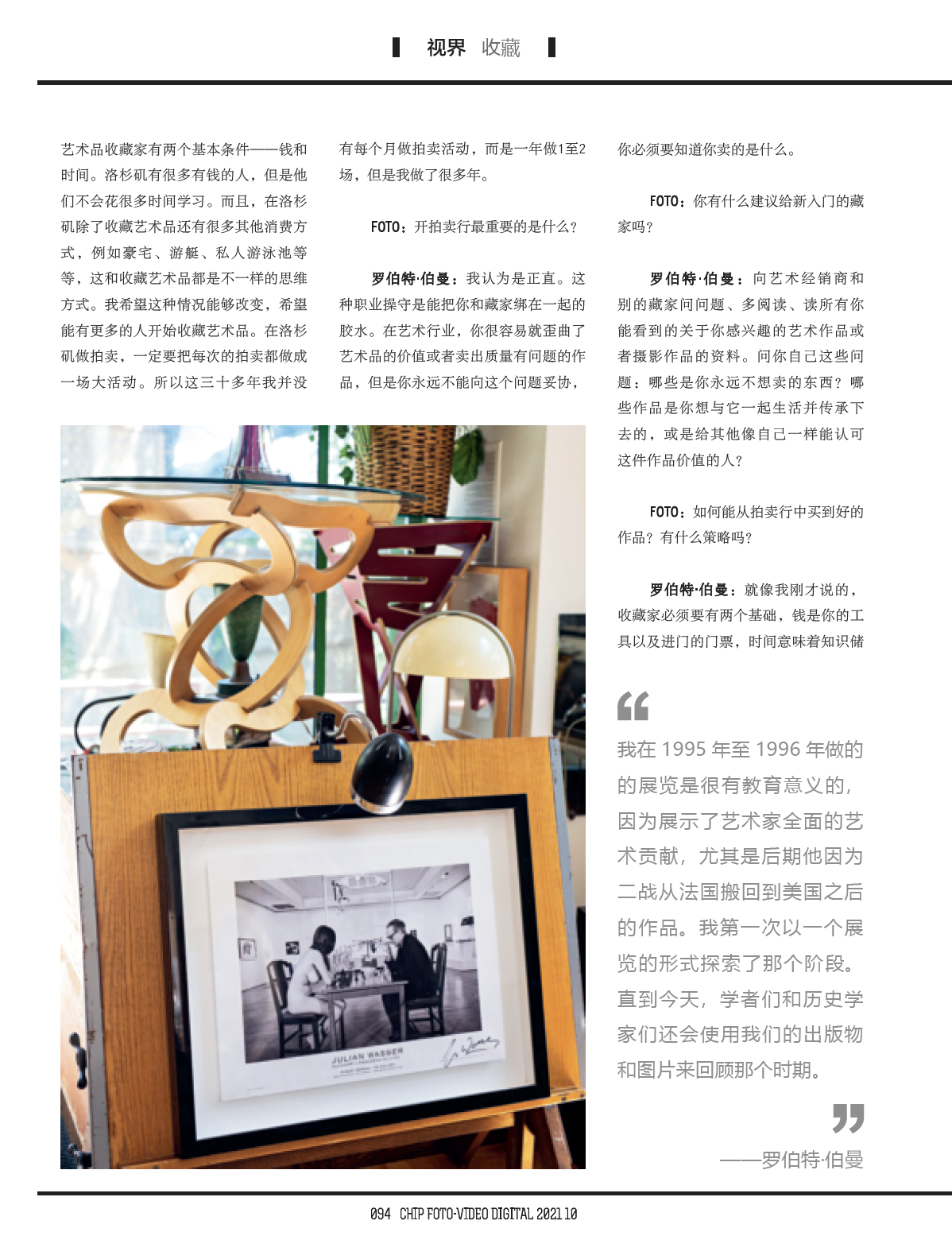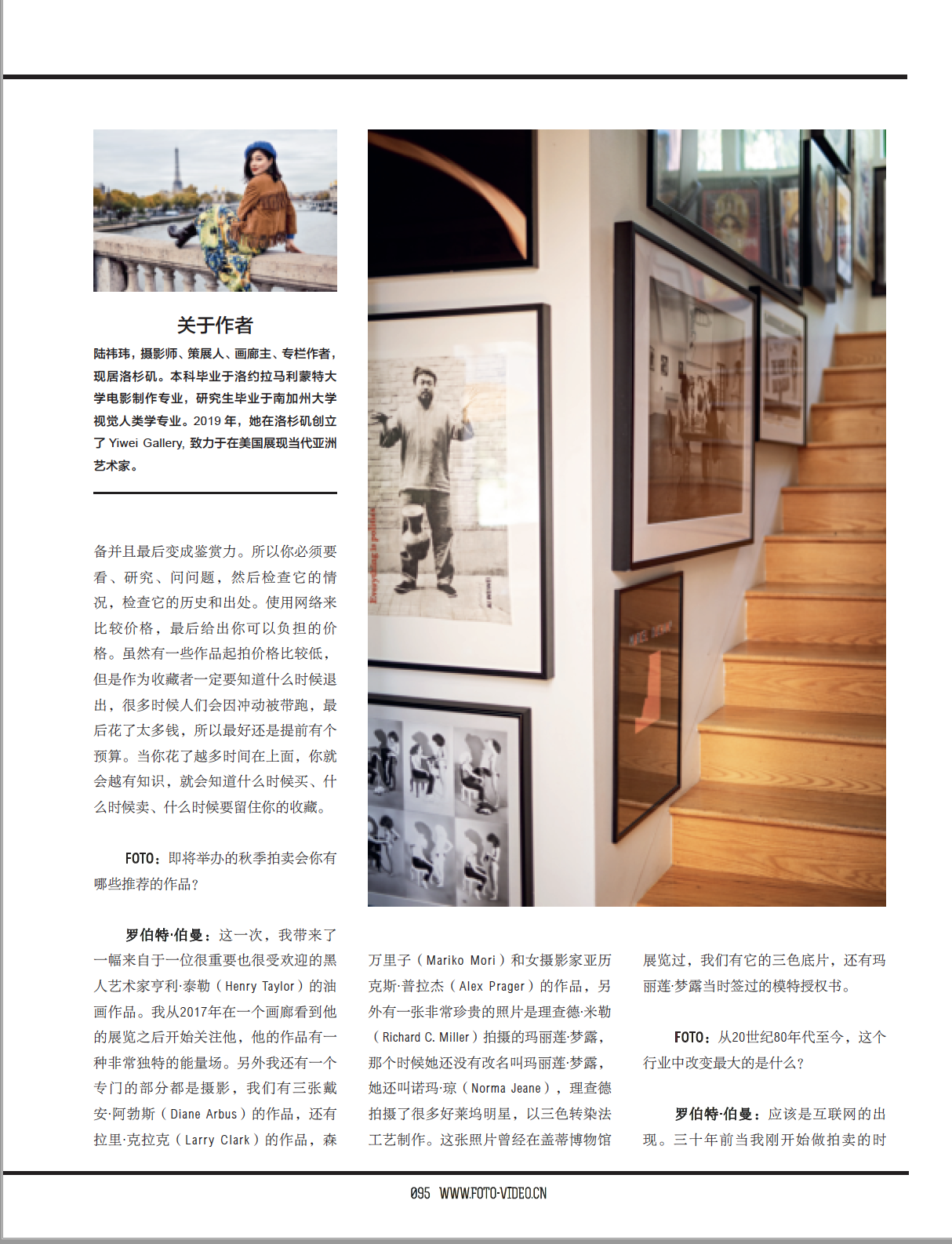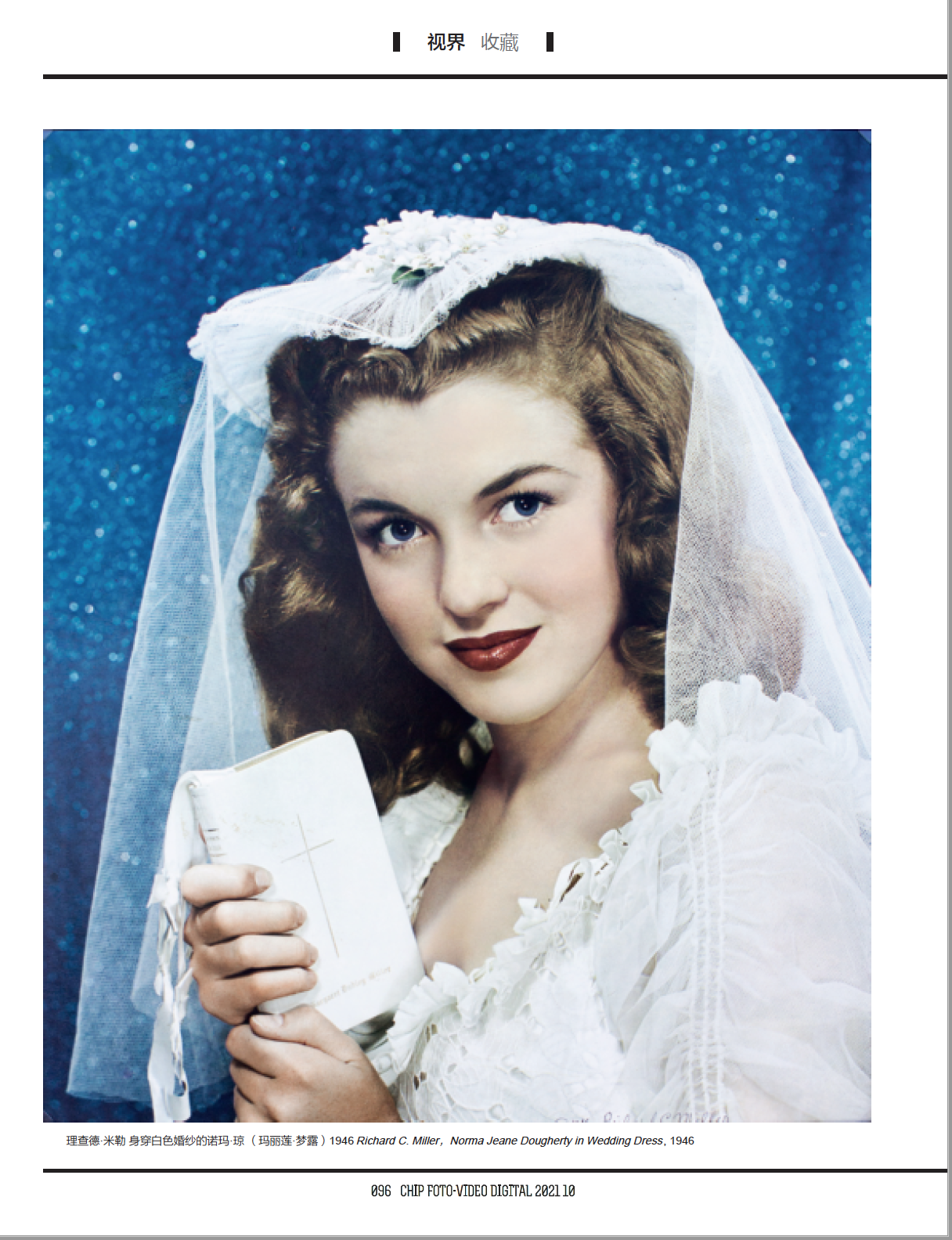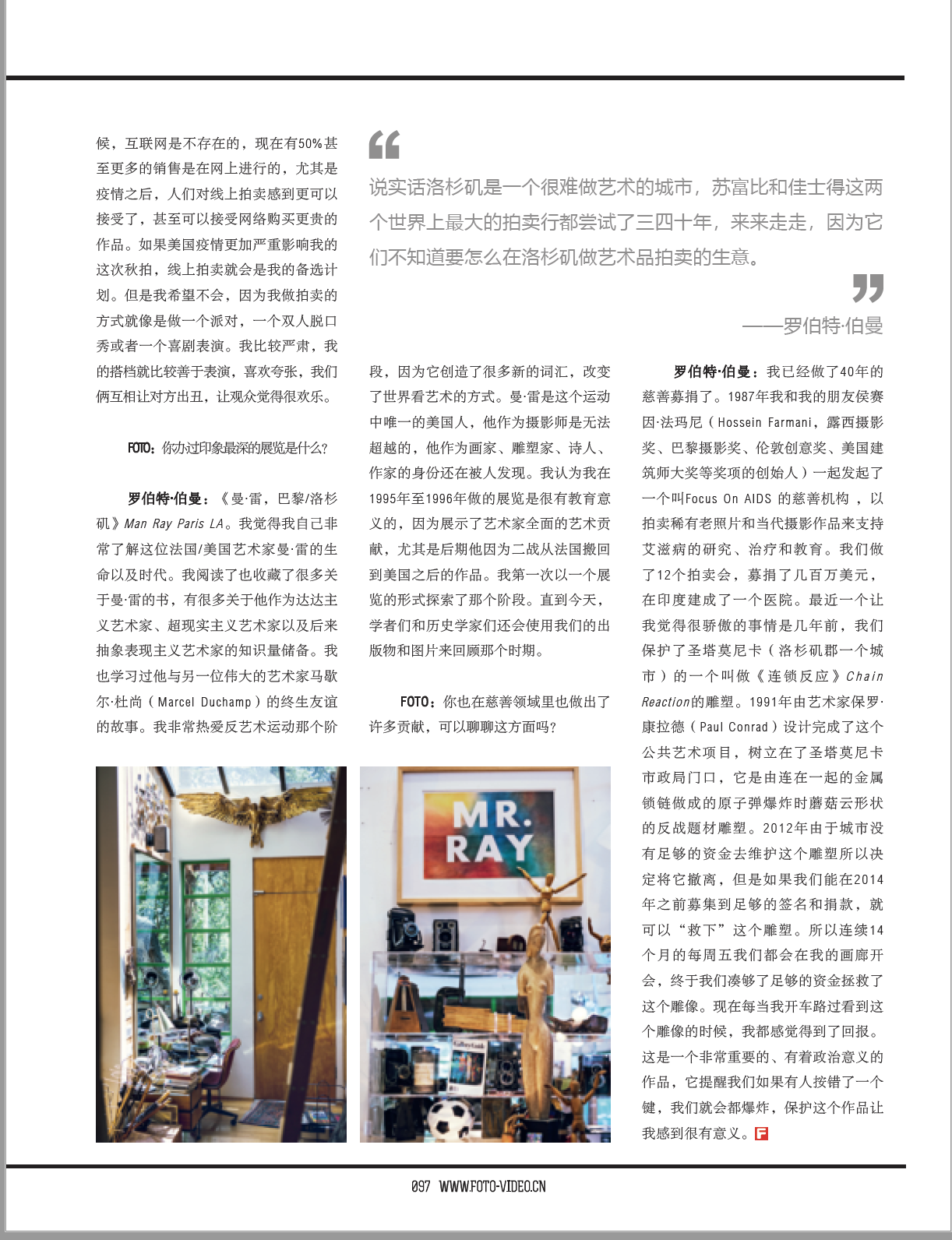Originally published in the Chinese edition of
Chip Foto Video magazine Oct. Issue, 2021
By Yiwei Lu
Robert Berman, an auction house owner in Los Angeles with over 40 years of experience in the art world, has blended art into his life. Berman’s house is the best display of his unique sense of taste. You can see very rare museum-quality artworks, and you can also find objects found at flea markets. The mix-and-match style is Berman’s statement for being an absolute maximalist. From my conversation with him, you will learn about his passion for the art world, his professionalism, and the ethics he cares about the most working in the art industry.
Lu: Why did you want to open an auction house in Los Angeles?
Berman: In Las Vegas, people who make money are the casino owners, not the gamblers, and it’s the same in the art world. I was motivated after living in Paris in the 70s. I lived a few blocks from Hôtel Drouot, the largest auction house in France, and I went there every day. I got my love and taste for art there, and found out that auctioning is a fun way to buy and sell art. I was always impressed that in France, you were not allowed to be an auction house specialist until you were certified by the government as an expert. They really understood what art is, what they were selling, and the story and value of each piece. When I got back to the U.S., I worked at an auction house for a bit, and when the opportunity came, I opened my own house. In my Santa Monica auction venue, we help new collectors to generate interest in art, and old collectors to look for specific things. LA is a really hard city to successfully do auctions. Both Christie’s and Sotheby’s have tried on and off for the last 30-40 years, but they were never able to stay here because they don’t understand how quickly LA people lose interest in collecting things like fine art.
Lu: Why do you think Los Angeles is a hard city to do art auction business?
Berman: In New York, art collecting is a part of their life and people are not afraid to buy at auctions. Money and time are the two things you need to be an art collector. In Los Angeles, there are a lot of wealthy people, but they might not spend a lot of time learning about art. There are too many other things you can spend money on other than collecting art - - big houses, swimming pools, yachts, etc- - but they require a different mindset. In Los Angeles, every time you have an auction, you have to make a big event out of it. Therefore, for the past 30 years, I insisted on doing only one or two auctions a year and each of them became its own event.
Lu: What is the most important quality for opening an auction house?
Berman: Integrity. Integrity is the glue that bonds you and collectors together. In the art industry, it is easy to misrepresent things and sell things that have issues. But you should never compromise. You always should know what you are selling.
Lu: Do you have any advice for beginning collectors?
Berman: Ask questions of other dealers and other collectors. Read, read, read all you can on the art or photographs you are interested in. Once you feel comfortable with the credibility of the auction house or the gallery, decide what are the things that bring you the most joy and happiness in your collecting. Ask yourself what are the things you never want to sell. Ask yourself what are the things you want to live with and pass on, either to an institution or to other people who would find the intrinsic value and satisfaction which these works have brought to you.
Lu: What are you the most excited about this fall auction?
Berman: Today, I locked in an original painting by a really significant African American artist Henry Taylor, someone I’ve been watching since his exhibition at Blum and Poe in 2017. His paintings are very illustrative and he has his own unique style. We also have one section just for photography. We have works by Diane Arbus, Larry Clark, Mariko Mori, and Alex Prager. There is a very beautiful and collectible photo of Marilyn Monroe by Richard Miller. When this was shot in 1946, she had her original name, Norma Jeane Mortenson. Richard Miller took photos of a lot of Hollywood celebrities and is known for his vintage carbro prints. This photo has been exhibited at the Getty Center before. We have the three original color negatives and the model release signed by Norma Jeane.
Richard C. Miller
Norma Jeane Dougherty in Wedding Dress, 1946
Vintage Carbro print; Signed in ink on recto; Signed and annotated on verso; Image: 15 x 12.5 inches
Lu: How to acquire a good piece from an auction house? Any strategy?
Berman: There are two basic things in collecting: one is money, which is the tool and accessibility, and the other is time, which is the form of knowledge and thus becomes connoisseurship. So you must look, research, ask questions, check on conditions, check on history including the provenance, use the internet to compare prices, and then come to a number that you are comfortable with. Start bidding at a lower number but know when to quit. For many times at auctions, people do get carried away and spend much more than they intended. Ironically, those might be the best purchases they ever had. But as a practice, it might be better to put a budget on your spending. The more time you put into research, the more knowledgeable you will become. Thus you will know when to buy, when to sell and when to hold on to your purchases.
Lu: What is the most memorable exhibition you have ever done?
Berman: MAN RAY, PARIS-LA. I consider myself very knowledgeable in the life and times of American/French artist Man Ray. I have read and collected many books about Man Ray. I knew well of him as a Dadaist, surrealist, and later abstract expressionist. I studied his lifelong friendship with the amazing artist Marcel Duchamp. I love the periods of representational art and anti-art because these art movements created a whole new vocabulary, and changed how the world looks at art. Man Ray was the only American who was part of all these incredible art movements. His work as a photographer is unsurpassed; his work as a painter, object maker, filmmaker, sculptor, and writer still are being discovered and explored. My exhibition in 1995 and 1996 with Track 16 Gallery was instrumental in showing most of his artistic endeavors, especially through a time later in his life (1940 to 1950), a time that he moved back to America because of the horrible conditions of the World War II. We explored this period for the first time as an exhibition. And to this day, scholars and historians use our catalogue and imagery to memorialize this period of this truly remarkable artist.
Lu: What is the biggest change in the art auction industry since the 80s?
Robert: Definitely the emergence of the Internet. When I first started 30 years ago, it was not a part of the deal, and after the pandemic, more than 50% of the sales are being done online. If Covid gets worse in LA, I’ll be able to do my auction only online as a backup plan. But I hope not. The way I do an auction is like a party, a comedy act, and a performance.
Lu: You also have done a lot in the charity field. Can you talk about that?
Berman: I have been doing charity and fundraising for over 40 years now. In 1987, I was involved in starting Focus on AIDS along with the principals Susan Baraz and Hossein Farmani (the founder of Lucie Awards). It was an auction fundraiser of rare, vintage, and contemporary photographs in support of AIDS research, care, and education. We did many auctions, raised millions of dollars, and built a hospital in India. One of the things I did that I feel the proudest of in recent years is that we protected a sculpture called Chain Reaction in Santa Monica. In 1991, Paul Conrad created this public art sculpture and it was installed in front of the Santa Monica Civic Center. It looks like a mushroom cloud created by a nuclear explosion and it is very political. In 2012, the city wanted to take it down because they didn’t have enough money to preserve it and some people did not like the message. Conrad’s son came to me because local activists were trying to raise money to keep the sculpture. We had meetings at my gallery every Friday for 14 months and we ended up getting enough money to save Chain Reaction. Every time when I drive past this sculpture, I feel extremely rewarded. It is a very important piece because it reminds us if someone presses the wrong button, the whole world might explode. Saving this sculpture means a lot to me.
The upcoming FALL(Back) auction will be held on Sunday, Nov. 7th in Bergamot Station Art Center, Santa Monica. (http://www.smauctions.com/)
Robert Berman:
Born in Chicago, Berman lived in Paris in his early years and moved to California later. He opened his first gallery in Los Angeles in 1979, and he opened SANTA MONICA AUCTIONS in 1984. Berman is a specialist in California artists and photography history, and he focuses on 20th-Century and 21st-century art.
Yiwei Lu:
Based in LA, Yiwei Lu is an artist, curator, and writer. She received her BA in film production from Loyola Marymount University and her MA in visual anthropology from the University of Southern California. In 2019, she founded Yiwei Gallery, dedicated to promoting the work of emerging Asian and Asian American artists.
2020年是艺术界大洗牌的一年,几家欢喜几家愁,许多中小画廊举步维艰,线下艺博会全面取消,但困境也带来了新的销售模式和机遇。艺术品线上交易得到了极大的推动,NFT市场变得火爆,也因此吸引来了新的藏家。在全球疫情的大背景下,国外大拍卖行有九个月都没有举行传统的现场拍卖,最后的拍卖成交额虽然出现了缩水但也展现出了很强的弹性。以苏世比拍卖行为例,2020年以50亿美元的成交额近年来第一次打败了佳士得,虽然比之19年下降了16%,但从它的年终报告中仍可以看出一些变化: 2020年苏世比70%的拍卖都是线上举行的(而2019年只有30%),80%的出价都是线上完成,且这其中超过40%的出价人都是苏世比新买家,40岁以下藏家的数量比之前年翻了一倍。
即使这两年拍卖行整体交易额下降,许多摄影作品的销售仍然十分抢眼。 2020年12月,苏世比以988,000美元的成交价拍卖了一副亚当斯作品—— 《提顿河与蛇河》,the Grand Tetons and the Snake River, Grand Teton National Park, Wyoming (1942) ,成了亚当斯作品的新纪录(上一次记录是2010年苏世比纽约拍卖会的$722,500)。 今年四月份,苏世比以 $1,956,000的价格成交了71张William Henry Fox Talbot (1800-1877)的老照片,这则新闻也登上了众多国际艺术媒体的头条。自从1971年苏世比在伦敦举行第一次摄影拍卖,随后1975年在纽约,摄影作品进入了越来越多的拍卖行。而经过这五十年的发展,摄影拍卖也水涨船高。 2020年,苏世比在36个拍卖中出售了摄影作品,总销售额达到2100万美元。
在笔者参加的一次摄影收藏讲座中,佳士得全球摄影部总监Darius Himes聊到曾经人们喜欢把摄影市场和艺术市场分开聊:最有钱的人收藏画,中产阶级收藏版画,这之外的人才收藏照片。但现如今随着摄影作品在拍卖会上强劲的表现,摄影市场和艺术市场早就融为其一。拿拍卖会上表现最好的1950年之后摄影师举例: Irving Penn, Richard Avedon, Diane Arbus, Robert Frank, Harry Callhan, William Eggelston……这些人在纽约没有一个是被专门的摄影画廊代理的,相反他们的作品全部被蓝筹画廊代理,比如高古轩,卓那和佩斯。从近两年的摄影拍卖信息来看,我们可以得出以下几个规律:摄影作品价格整体上涨;贵和稀少的作品更受欢迎了;随着线上拍卖的普及,越来越多的国际藏家和年轻藏家涌入了市场;中低端价位的照片仍然性价比很高。可以说,现在是进入市场极佳的时机。
这一次我们邀请到了在洛杉矶有四十年艺术从业经历的拍卖行主理人Robert Berman,来跟我们分享他对于艺术与拍卖的看法,以及将艺术融进生活的态度。在他的家中,无处不可见他的独特品味:有一些是罕见珍贵的博物馆级艺术品,有一些则是他从跳蚤市场淘来的小物件,这种混搭形成了一种十分鲜明的“极繁主义”个人风格。在和他的对话中,则可以感受到出他对艺术和艺术界的热爱,多年累积的专业素养,以及他最佳看重的职业道德。
-
Q: 为什么想在洛杉矶开设拍卖行?
A: 在拉斯维加斯,赚钱的永远不会是赌徒,而是庄家。艺术界也一样。70年代我曾在巴黎生活过,住得地方离一个大拍卖行很久,所以我每天都会去。在那里我学会了对艺术拍卖的热爱和品味,我发现拍卖是个很有意思的买卖艺术以及与人交往的方式。并且让我觉得很可贵的是,在法国如果你想在拍卖行工作,你必须得是政府承认的专家,你要知道你卖的是什么,你要知道它的故事、历史和价值。回美国之后,我在一家短暂的拍卖行工作过,然后当机会来临的时候我就开设了自己的拍卖行。拍卖可以让新藏家产生对艺术的兴趣,老藏家寻找到他们想找的东西。但说实话洛杉矶是一个很难的城市,苏世比和佳士得这两个世界上最大的拍卖行都尝试了三四十年,来来走走,因为它们不知道要怎么在洛杉矶做。
Q: 为什么说在洛杉矶开拍卖行很难?
A: 因为洛杉矶不是纽约,收藏艺术是他们生活的一部分,他们不会感到害怕去一个拍卖行。之前我说藏家有两个基本:钱和时间。洛杉矶有很多有钱的人,但是他们不会花很多时间学习。另外除了收藏艺术,洛杉矶还有很多其他消费方式:豪宅,游艇,游泳池,这和收藏艺术都是不一样的思维方式。我希望这种情况能改变,希望能有更多的人开始收藏艺术。在洛杉矶做拍卖,一定要把每次的拍卖都做成一个非常大的活动。所以这三十多年我并没有每个月做拍卖,大约一年1-2个,但是我做了很长的时间。
Q: 开拍卖行最重要的是什么?
A: 正直感。这种职业操守是能把你和藏家绑在一起的胶水。在艺术行业,你很容易就歪曲了艺术品或者卖出质量有问题的东西,但是你永远不能妥协。你必须要知道你到底卖的是什么。
Q: 你有什么建议给新入门的藏家吗?
A:向艺术经销商和别的藏家问问题;多阅读,读所有你能看到的关于你感兴趣的艺术作品或者摄影作品的材料。一旦你感觉对某一个画廊或者拍卖行的可信度感到舒服的时候,再考虑收藏什么能给你带来最大的快乐。问你自己这些问题:哪些是你永远不想卖的东西?哪些是你想一起生活然后传承下去的,亦或是给机构,亦或是给其他像你这样能找到这件作品无与伦比价值的人?
Q: 如何能从拍卖行中买到好的作品?有任何策略吗?
A: 藏家必须要知道他们在收藏的时候有两个基础的:钱(是你的工具以及进门的门票),以及时间(意味着知识储备最后变成鉴赏力)。所以你必须要看,研究,问问题,检查它的情况,检查它的历史包括出处,使用网络来比较价格最后想一个在你舒适区内的底价。以一个比较低的价格开拍,但是一定要知道什么时候推出。很多时候在拍卖会的时候,人们会被带跑最后花了太多钱,所以最好还是提前有个预算。当你花了越多时间在上面,你就会越有知识,就会知道什么时候买、什么时候卖、什么时候要留住你的收藏。
Q:即将举办的秋季拍卖会你有哪些推荐的作品?
A: 今天我锁定了一副来自于一个很重要也很受欢迎的黑人艺术家Henry Taylor的油画原作。我从2017年在一个画廊看到他的展览之后开始非常关注他的职业,他的作品有一种非常独特的能量场。另外我还有一个专门的一个部分都是摄影,我们有三张Diane Arbus, 还有Larry Clark,Mariko Mori和 Alex Prager。有一张非常珍贵的照片是Richard C. Miller拍摄的玛丽莲梦露,那个时候她还没有改名叫玛丽莲梦露,她还叫Norma Jeane. Richard 拍摄了很多好莱坞明星,以他的三色碳溴法(carbro process)出名。这张照片曾经在盖蒂博物馆展览过,我们有它的三色底片,还有Norma Jeane (也就是玛丽莲梦露)当时签过的模特授权书。
Q: 从20世纪80年代至今,这个行业中改变最大的是什么?
A: 互联网的出现。三十年前当我刚开始做拍卖的时候,互联网是不存在的。现在大约有50%甚至更多的销售是在网上进行的,尤其是疫情之后,人们对线上拍卖感到更舒服了,甚至是贵的东西。如果美国疫情更加严重影响我的这次秋拍,线上拍卖就会是我的备份计划。但是我希望不会,因为我做拍卖的方式就像是开一个派对一样,一个双口相声,一个喜剧表演。我比较严肃,我的搭档就比较喜欢夸张,我们俩互相让对方出丑,让观众觉得很好玩。
Q: 您办过印象最深的展览是什么?
A: Man Ray Paris LA (曼·雷 巴黎 洛杉矶)。我觉得我自己非常了解这位美国/法国艺术家曼·雷的生命以及时代。 我读了也收藏了很多关于曼·雷的书,有很多关于他作为达达主义艺术家、超现实主义艺术家以及后来抽象表现主义艺术家的知识量储备。我也学习过他与另一位伟大的艺术家马歇尔·杜尚的终生的友谊。我非常热爱反艺术运动那个阶段,因为它创造了很多新的词汇,改变了世界看艺术的方式。曼·雷是这个运动中唯一的美国人,他作为摄影师是无法超越的,他作为画家、雕刻家、艺术品制作家、诗人、作家的身份还在被人发现。我1995-1996年的展览是很有教育意义的,因为展览了艺术家的全面的艺术贡献,尤其是他后期因为二战从法国搬回到美国之后的作品(1940-1950年)。我们第一次作为一个展览的形式探索了那个阶段,直到今天,学者们和历史学家们还会使用我们的出版物和图片来纪念那个时期。
Q: 您在慈善领域里也做出了许多贡献,可以聊聊这方面吗?
A:我已经做了40年的慈善募捐了。1987年我和我的朋友 Hossein Farmani (露西奖的创始人)一起发起了一个叫Focus On AIDS 的慈善机构 ,以拍卖稀有老照片和当代摄影作品来支持艾滋病的研究、治疗和教育。我们做了12个拍卖会,募捐了几百万美元,在印度建成了一个医院。最近一个让我觉得很骄傲的事情是几年前,我们保护了圣塔莫尼卡(洛杉矶郡一个城市)的一个叫做连锁反应(Chain Reaction)的 雕塑。1991年艺术家Paul Conrad设计完成了这个公共艺术项目,树在了圣塔莫尼卡市政局门口,它是由连在一起的金属锁链做成的原子弹爆炸时蘑菇云形状的反战题材雕塑。2012年城市由于没有足够的资金去维护这个雕塑决定将它撤离,但是如果我们能在2014年之前募集到足够的签名和捐款,就可以”救下“这个雕塑。所以连续14个月,每周五我们都会在我的画廊开会,终于我们凑够了足够的资金拯救了这个雕像。现在每当我开车路过看到这个雕像的时候,我都感觉得到了回报。 这是一个非常重要的政治作品,它提醒我们如果有人 按错了一个键,我们就会都爆炸,保护这个作品让我感到很有意义。








